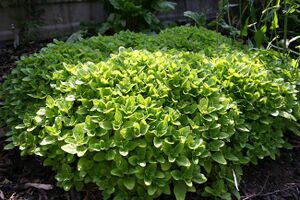Oregano

Oregano is often used in tomato sauces, fried vegetables and grilled meat. Together with basil, it contributes much to the distinctive character of many Italian dishes.
Oregano combines nicely with pickled olives, capers, and lovage leaves. Unlike most Italian herbs, oregano works with hot and spicy food, which is popular in southern Italy.
Oregano is an indispensable ingredient for Greek cuisine. Oregano adds flavour to Greek salad and is usually used separately or added to the lemon olive oil sauce that accompanies many fish or meat barbecues and some casseroles.
It has an aromatic, warm and slightly bitter taste. It varies in intensity; good quality is so strong that it almost numbs the tongue, but the cultivars adapted to colder climates have often unsatisfactory flavour. The influence of climate, season and soil on the composition of the essential oil is greater than the difference between the various species.
It is an important ingredient in someZa'atar spice mixtures.
Mexican oregano
Mexican oregano, Lippia graveolens (Verbenaceae) is closely related to lemon verbena. It is a highly studied herb that is said to be of some medical use and is common in curandera female shamanic practices in Mexico and the Southwestern United States. Mexican oregano has a very similar flavour to oregano, but is usually stronger. It is becoming more commonly sold outside of Mexico, especially in the United States. It is sometimes used as a substitute for epazote leaves; this substitution would not work the other way round.
Several other plants are also known as oregano in various parts of Mexico, including Poliomintha longiflora, Lippia berlandieri, and Plectranthus amboinicus (syn. Coleus aromaticus), also called Cuban oregano.
Alternatives
Marjoram would be a reasonable substitute.
Great with:
- Anchovies
- Artichokes
- Aubergines
- Beans and pulses
- Cabbage
- Carrots
- Chicken
- Duck
- Eggs
- Fish and shellfish
- Lamb
- Mushrooms
- Onions
- Peppers
- Pork
- Potatoes
- Squashes
- Spinach
- Sweetcorn
- Tomatoes
- Turkey
Find recipes that contain 'Oregano'
#oregano #chicken #duck #carrots #lovage #artichokes #pickledolives #sweetcorn #turkey #lamb #marjoram